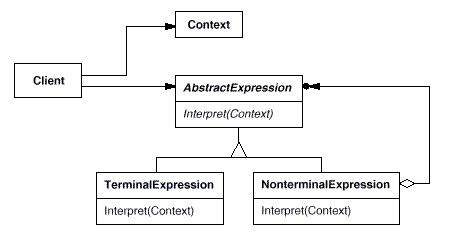设计模式——迭代模式
| 称 | Iterator |
| 结构 |  |
| 意图 | 提供一种方法顺序访问一个聚合对象中各个元素, 而又不需暴露该对象的内部表示。 |
| 适用性 |
|
| Code Example |
1  // Iterator // Iterator2  3  // Intent: "Provide a way to access the elements of an aggregate object // Intent: "Provide a way to access the elements of an aggregate object 4  // sequentially without exposing its underlying representation". // sequentially without exposing its underlying representation". 5  6  // For further information, read "Design Patterns", p257, Gamma et al., // For further information, read "Design Patterns", p257, Gamma et al.,7  // Addison-Wesley, ISBN:0-201-63361-2 // Addison-Wesley, ISBN:0-201-63361-28  9  /* Notes: /* Notes:10  * Here wish wish to separate node traversal from the nodes themselves. * Here wish wish to separate node traversal from the nodes themselves. 11  * STL in ISO C++ is a highly successful application of this pattern. * STL in ISO C++ is a highly successful application of this pattern.12  * Generic programming is a great way to implement iterators. As this is * Generic programming is a great way to implement iterators. As this is 13  * not yet in C#, we use inheritance. * not yet in C#, we use inheritance. 14  * * 15  */ */16  17  namespace Iterator_DesignPattern namespace Iterator_DesignPattern18  { {19  using System; using System;20  using System.Collections; using System.Collections;21  22  class Node class Node 23  { {24  private string name; private string name;25  public string Name public string Name 26  { {27  get get 28  { {29  return name; return name; 30  } }31  } }32  public Node(string s) public Node(string s)33  { {34  name = s; name = s;35  } }36  } }37  38  class NodeCollection class NodeCollection 39  { {40  private ArrayList list = new ArrayList(); private ArrayList list = new ArrayList();41  private int nodeMax = 0; private int nodeMax = 0;42  43  // left as a student exercise - implement collection // left as a student exercise - implement collection44  // functions to remove and edit entries also // functions to remove and edit entries also45  public void AddNode(Node n) public void AddNode(Node n)46  { {47  list.Add(n); list.Add(n); 48  nodeMax++; nodeMax++; 49  } } 50  public Node GetNode(int i) public Node GetNode(int i)51  { {52  return ((Node) list[i]); return ((Node) list[i]);53  } }54  55  public int NodeMax public int NodeMax 56  { { 57  get get 58  { {59  return nodeMax; return nodeMax;60  } }61  } }62  } }63  64  /* /*65  * The iterator needs to understand how to traverse the collection * The iterator needs to understand how to traverse the collection 66  * It can do that as way it pleases - forward, reverse, depth-first, * It can do that as way it pleases - forward, reverse, depth-first, 67  */ */68  abstract class Iterator abstract class Iterator 69  { {70  abstract public Node Next(); abstract public Node Next(); 71  } }72  73  class ReverseIterator : Iterator class ReverseIterator : Iterator74  { {75  private NodeCollection nodeCollection; private NodeCollection nodeCollection;76  private int currentIndex; private int currentIndex;77  78  public ReverseIterator (NodeCollection c) public ReverseIterator (NodeCollection c)79  { {80  nodeCollection = c; nodeCollection = c; 81  currentIndex = c.NodeMax -1; // array index starts at 0! currentIndex = c.NodeMax -1; // array index starts at 0!82  } }83  84  // note: as the code stands, if the collection changes, // note: as the code stands, if the collection changes,85  // the iterator needs to be restarted // the iterator needs to be restarted 86  override public Node Next() override public Node Next()87  { {88  if (currentIndex == -1) if (currentIndex == -1)89  return null; return null;90  else else 91  return(nodeCollection.GetNode(currentIndex--)); return(nodeCollection.GetNode(currentIndex--));92  } }93  } }94  95  /// <summary> /// <summary>96  /// Summary description for Client. /// Summary description for Client.97  /// </summary> /// </summary>98  public class Client public class Client99  { {100  public static int Main(string[] args) public static int Main(string[] args)101  { { 102  NodeCollection c = new NodeCollection(); NodeCollection c = new NodeCollection();103  c.AddNode(new Node("first")); c.AddNode(new Node("first"));104  c.AddNode(new Node("second")); c.AddNode(new Node("second"));105  c.AddNode(new Node("third")); c.AddNode(new Node("third"));106  107  // now use iterator to traverse this // now use iterator to traverse this108  ReverseIterator i = new ReverseIterator(c); ReverseIterator i = new ReverseIterator(c);109  110  // the code below will work with any iterator type // the code below will work with any iterator type111  Node n; Node n;112  do do 113  { {114  n = i.Next(); n = i.Next();115  if (n != null) if (n != null) 116  Console.WriteLine("{0}", n.Name); Console.WriteLine("{0}", n.Name);117  } while (n != null); } while (n != null);118  119  return 0; return 0;120  } }121  } }122  } }123  124  |










 浙公网安备 33010602011771号
浙公网安备 33010602011771号